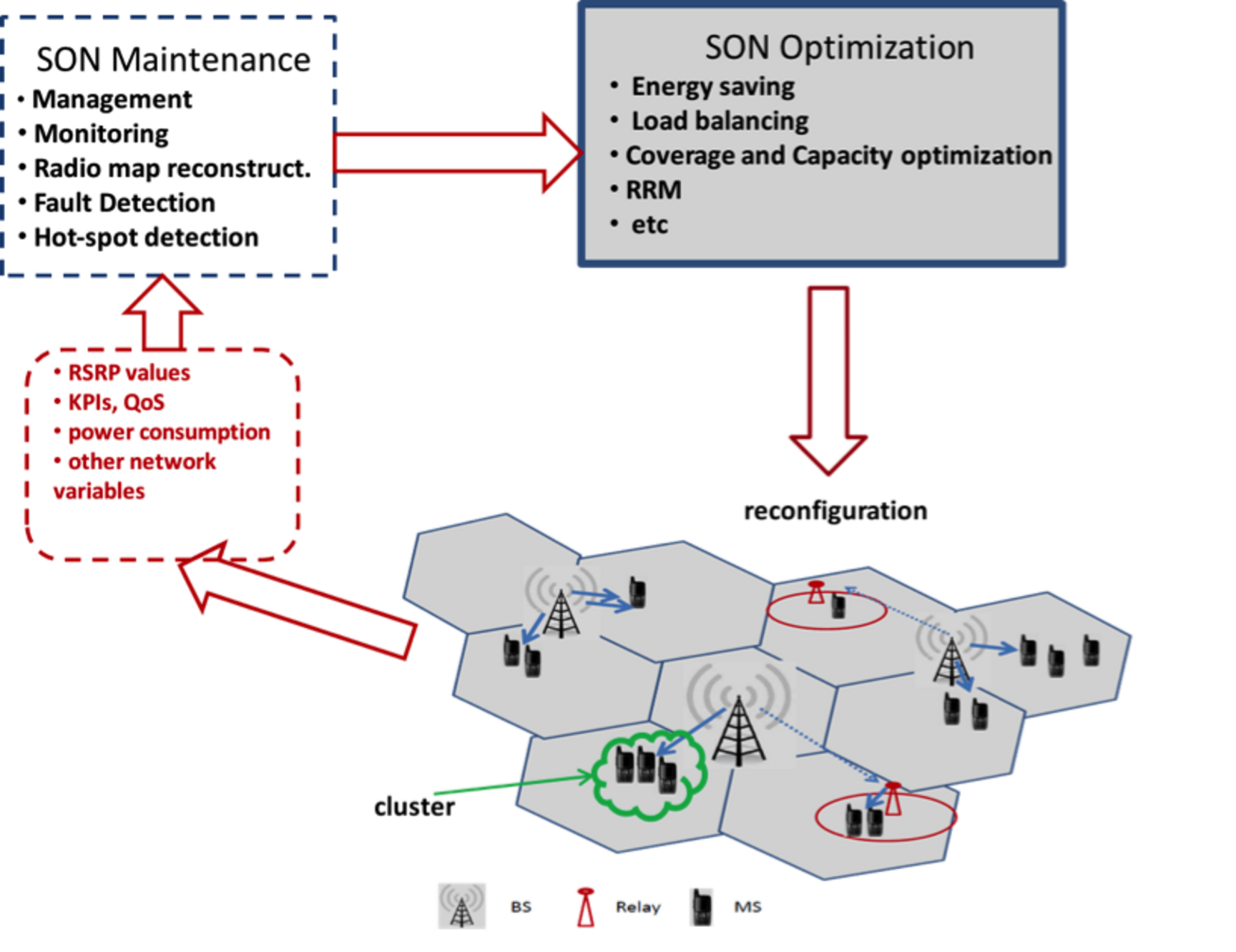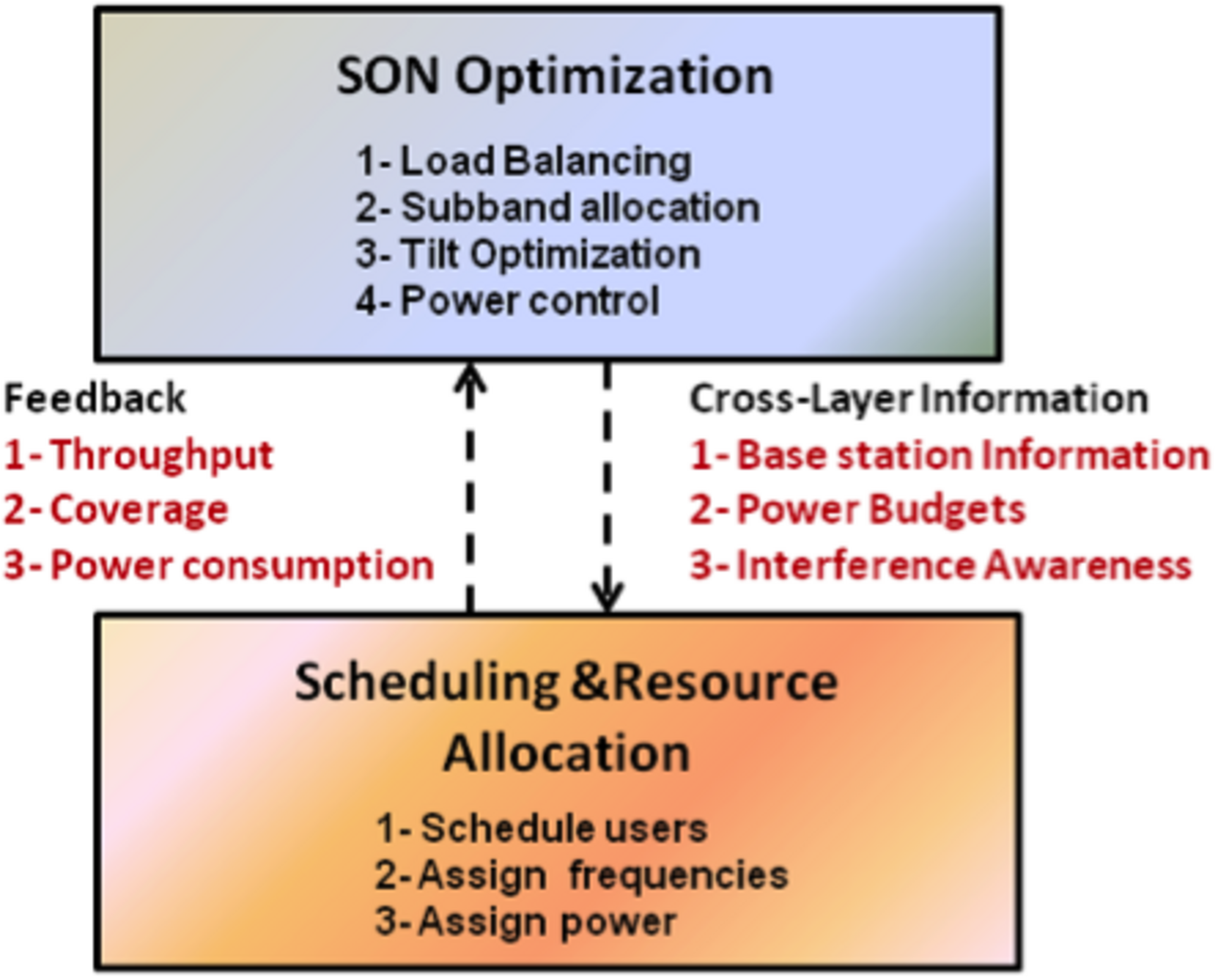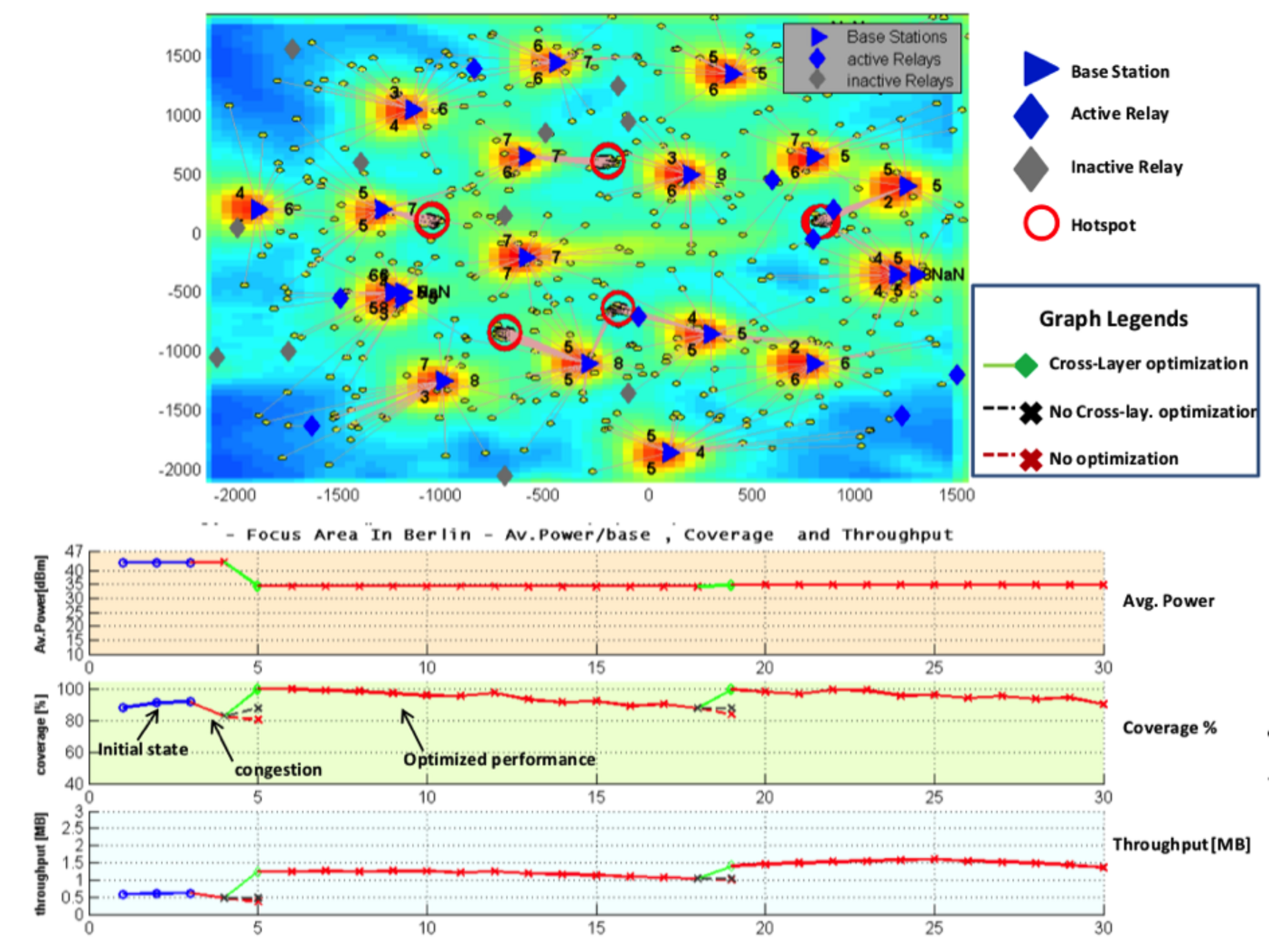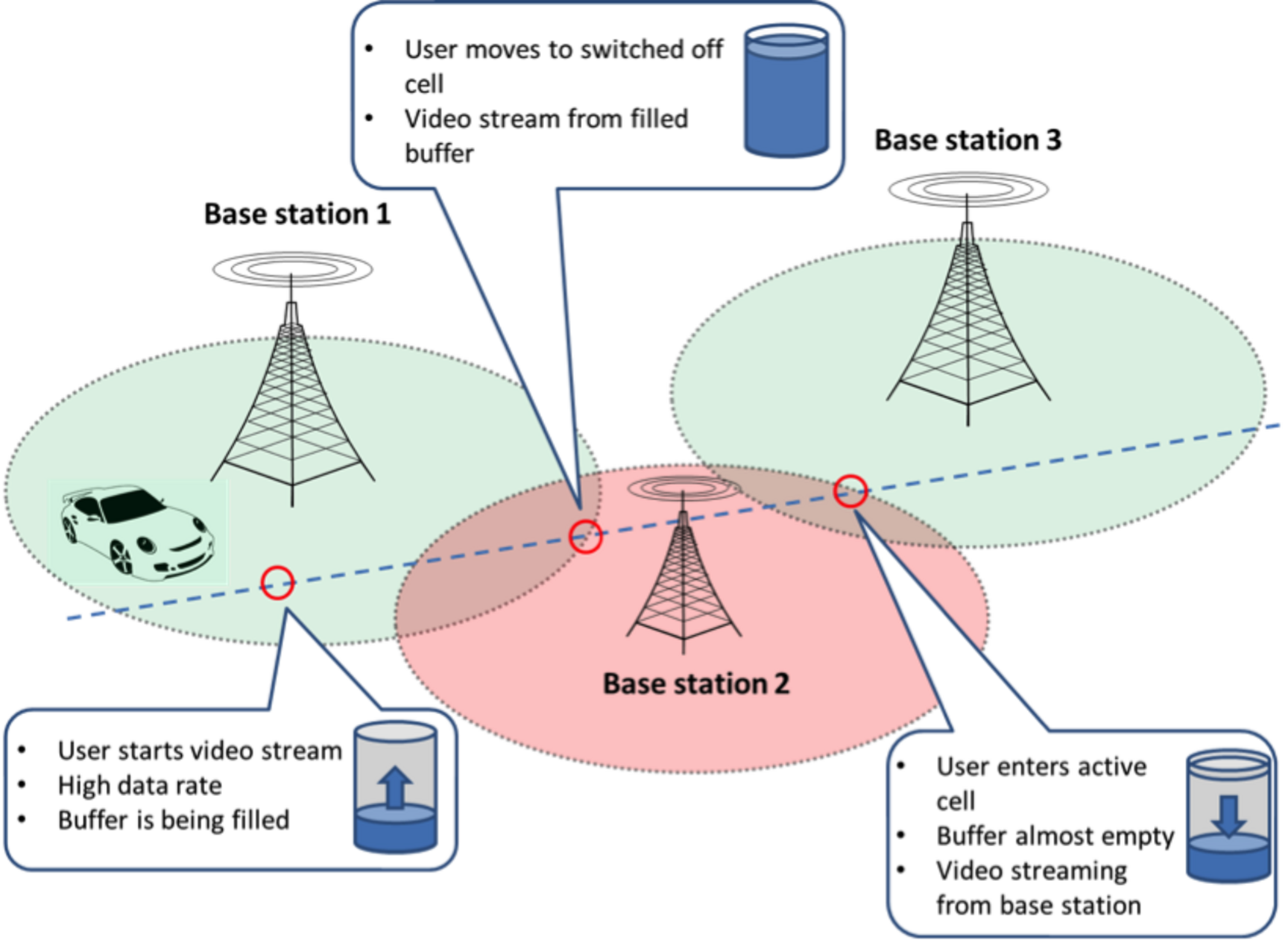Existing approaches to network management and self-organisation are inadequate to cope with the growth of autonomous network elements as well as partial and uncertain network knowledge. Our research efforts aim at redesigning wireless network management approaches in order to eliminate or at least mitigate the deficiencies of existing solutions. This amounts to ensuring real-time system identification and network-wide self-optimisation of wireless networked entities. System identification refers to the crucial capability of extracting knowledge from the network about network state and network surroundings in the presence of uncertainty and incompleteness, while network-wide self-optimisation refers to the procedure of incorporating real-time system identification into the network management control loop to drive the network to a desired operational point in a self-coordinated fashion.

Briefly, the following topics have received considerable attention from our researchers:
- Coverage and Capacity Optimization
- Handover optimization
- Energy optimisation
- Antenna tilt optimization
- Load balancing
- Coordination of multiple use cases
- Network topology optimisation for particular services (e.g., video transmission for highly mobile users)
Selected publications:
- R. L. G. Cavalcante, S. Stanczak, M. Schubert, A. Eisenblätter, and U. Türke, "Toward Energy-Efficient 5G Wireless Communication Technologies," IEEE Signal Processing Magazine (to appear)
- E. Pollakis, R. L. G. Cavalcante, and S. Stanczak, "Base station selection for energy efficient network operation with the majorization-minimization algorithm," in Proc. IEEE 13th International Workshop on Signal Processing Advances in Wireless Communications (SPAWC), June 2012 (Award Winning Paper)
- E. Pollakis, R. L. G. Cavalcante, S. Stanczak, "Enhancing energy efficient network operation in multi-RAT cellular environments through sparse optimisation," in Proc. IEEE 14th International Workshop on Signal Processing Advances in Wireless Communications (SPAWC), Darmstadt, Germany, June 2013
- Q. Liao, S. Stanczak, and F. Penna, “A Statistical Algorithm for Multi-Objective Handover Optimization Under Uncertainties,” IEEE Wireless Communications and Networking Conference (WCNC'13), Shanghai, China, Apr. 2013
- Q. Liao, F. Penna, S. Stanczak, Z. Ren, and P. Fertl, “Context-Aware Handover Optimization for Relay-Aided Vehicular Terminals,” The IEEE 14th Workshop on Signal Processing Advances in Wireless Communications (SPAWC), Darmstadt, Germany, June 2013.
Example: Cross-layer design for self-organising networks
We developed novel cross-layer techniques and algorithms for optimisation of self-organising networks. A special focus has been attached to coverage and capacity (CCO) optimisation through load balancing, power control and tilt optimisation of base stations. However, in order to achieve robust and reliable performance through optimisation, it is crucial that some vital information is exchanged across network layers so that the performance goals of different layer do not contradict each other. This leads to a cross-layer design where radio resource management is guided by SON algorithms to achieve network-wide objectives. The approach is illustrated in the figure below.

The proposed cross-layer scheme was tested on realistic realistic city scenario with arbitrary cell shapes and coverage holes. To this end, we used the pathless and cell-cite data for the city of Berlin combined with road traffic data obtained from OpenStreetMaps use it in conjunction with the vehicular mobility simulator SUMO.

The presented simulation scenario corresponds to a situation where performance degradation in coverage and throughput occurs due to several hot-spots at the edge of some cells. The goal is to compensate the degradation by adapting SON and RRM control parameters.
Example: Exploiting mobility and delay-tolerance of video content for energy savings
The analysis and development of wireless communication systems have traditionally considered only the energy radiated by antennas. However, with the densification of the networks, by using information-theoretic arguments, we can show that the energy consumed by hardware (e.g., to operate power amplifiers and to perform signal processing tasks) cannot be neglected if networks are to be energy efficient. In fact, many communication schemes that aim at reducing the transmit energy per bit may actually increase the total energy consumption because of the inefficiencies of the additional required hardware and signal processing operations. Therefore, it is becoming increasingly important to devise schemes that adjust the capacity of the network to the demand by switching off unnecessary network elements or by adapting the transmission strategies.
For instance, we have devised scalable approaches that exploit in a natural way specificities of particular services, such as video streaming in highly mobile environments. We exploit the possibility to preload/pre-fetch and save data on user devices to disengage certain network components. The basic idea is illustrated with help of the following example.

We have a single user which moves along a known route. The user wants to stream a video over the whole time. On its route the user passes through the service area of three cells. The user gets a higher data rate in the first cell such that the video can be preloaded in the user’s buffer. While trespassing the service area of the second cell the user is able to load the video content from its buffer instead of streaming it from the cell. When entering in the service area of the third cell, the buffer might be almost empty and the streaming is continued from cell three. In this simple example cell two can be deactivated and we are able to decrease the network energy consumption.
Additionally to the services like video streaming which can be loaded in the user’s buffer, there are a variety of services where the delay is not a crucial criterion for the QoS. An example would be sending and receiving emails. Such a service is not time critical and could be scheduled to be performed in a cell which supports an energy efficient network operation.
The video demonstrates the service scheduling for a three user scenario with several macro and micro base stations. Active base stations are indicated by a green coverage area and a line connecting the user they serve.